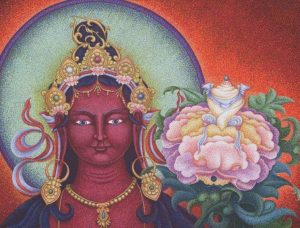The Mogao Grottoes, or the Thousand Buddha Grottoes, are a collection of caves carved out of the eastern face of Mingsha Mountain at three levels, close to the modern-day town of Dunhuang in northwestern China. An extensive collection of Buddhist artwork, including paintings, sculptures, and manuscripts, are carefully watched over and preserved by the Dunhuang Research Academy in the more than 700 caves that make up the site. It is one of the most important heritage sites in China, and one of the first to be listed as a UNESCO World Heritage Site in 1987, along with the Ming-Qing palaces of Beijing, the Great Wall, and the First Emperor’s mausoleum in Xi’an.
Cave 275 is one such cave. Its distinctive representation of Buddhist ethical ideas and precepts is particularly noteworthy. Thought to date to the Northern Liang period (397–439 CE), Cave 275 is believed to have been used for meditation and Dharma dissemination. (Bell 2000, 64) If one has the good fortune to visit the site, or even its digital replica at the nearby Mogao visitor’s center, one can almost feel the presence of long-gone monastics gathering to prostrate before the great Maitreya statue, or to sit cross-legged facing the murals and chapels that adorn the sides of the cave. The monk-pilgrims Faxian (337–422) and Xuanzang (602–64) also recorded their own visits to Cave 275.
Cave 275 can be thought of as a “Maitreya cave.” (Duan and Chung 1994, 68) This statue is unique: Maitreya is seated on a foot stool or tiny rug with ankles crossed, his feet resting on two spherical items that were likely lotuses in their original form. His crown consists of three disks, the middle of which depicts a buddha in holding the dhyana mudra. (Bell 2000, 64–5) The outer ring resembles licking flames, which could hearken back to early Indic or even Persian and Middle Eastern influences.
The power of the bodhisattva
The moral stories and teachings depicted in Cave 275 are notable not only for their artistic value, but also for their capacity to convey two core ideas: Buddhist morality and the bodhisattva ethic. The artists were likely commissioned by patrons (and the monks teaching them) to use the Jatakas, ancient tales of the Buddha’s past lives, as sources for the mural art.
The Jatakas, far from being dry philosophical or technical expositions, bring to vivid life the Buddha’s compassion and love for all beings, and would have been critical to Buddhist missionary activity across Asia, inspiring whole communities of devotees to aspire toward the Buddha’s ideal. As Ulrich Pagel notes:
While the philosophy of sunyata has evoked immense attraction among generations of scholars and intellectuals, it was the teachings about the bodhisattva that made the Mahayana successful as a religion across Asia. Not only could it easily win admiration, but being adjustable to an infinite variety of human circumstances the bodhisattva doctrine could also be taken as the basis for immediate action. As a central component of Mahayana spirituality, the bodhisattva concept was therefore an integral part and corner stone of all missionary activity.
(Pagel 1995, 69)
To the present day, iconographic depictions and wall-paintings across Asia bear witness of the repute and affection in which the accounts of Sakyamuni’s former lives were held. . . . On the one hand, the jataka served to authenticate the practices themselves. On the other hand, their role was to inspire faith in the image of the bodhisattva. They not only made the scope of the new ideal clear, but more importantly for the conversion of other peoples, they provided the urgently required proof that its sublime accomplishments were attainable.
(Pagel 1995, 114)
The murals in Cave 275 act as visual aids for the dissemination of the Jatakas’ messages, communicating Buddhist morality to a range of people, including those who would have been illiterate or unfamiliar with Buddhist philosophy. The murals also served as a form of spiritual practice for the artists and benefactors who commissioned them, as it is believed that creating or sponsoring religious art generates merit and good karma.
The Bhilanjili Jataka
This jataka aims to show how King Bhilanjili used the virtue (one of the six paramitas) of energy (virya) to harness the Dharma’s power, not only as part of the path to enlightenment, but also as a source of protection.
According to the Bhilanjili Jataka, Sakra Devendra (the Buddhist interpretation of the Vedic deity Indra), who in Buddhist myth is the god of the devas, approached a king called Bhilanjili and inserted a needle into each hole containing hair in his body. However, rather than screaming in pain from a presumably vicious attack, the monarch was a student of the Dharma that was able to enter a state of contemplation in which he was pain-free. (Bell 2000, 71)
The Bhilanjili Jataka version mentioned above has a more detailed inspiration and content than the Xianyu jing (賢愚經). In the Xianyu jing, it is a hostile brahmin who “drove the thousand iron nails into the body of the king”, which does correspond to the depictions in Cave 275 where the brahmin is shown driving the nails into King Bhilanjili’s body. (Bell 2000, 71)
The Sibi Jataka
The Sibi Jataka is about two gods of great antiquity, Indra (again) and Agni. They are none other than the prime celestials mentioned in the Rig Veda. who arrived to test the new king of Sibi who was renowned for his generosity. The hawk began chasing the terrified pigeon, which collapsed onto King Sibi’s lap. The hawk consented to leave the pigeon alone if the king offered a piece of his own flesh of equal weight. However, after removing flesh from various areas of his body and weighing it, the king discovered that the pigeon was still heavier. The king therefore placed his entire body on the scale, but was still unable to match the weight of the pigeon. The hawk and the pigeon revealed their true identities and presented the king with gifts for his boundless generosity.
In Cave 275, the Sibi Jataka is an exact duplicate of the Sibi Jataka narrative in the second cave of Tuyoq Valley, (Duan and Chung 1994, 94) however, there are multiple versions that do not correspond to Cave 275: for instance, in the Liudu jing (六度集經), the Zhongjing zuan za bu yu jing (眾經撰雜譬喻), and the Xianyu jing. In the Tuyoq Valley version, the king personally cuts his flesh, whereas in Mogao Caves 275, 254, and 85, someone else does the deed. (Bell 2000, 73)

The Chandraprabha Jataka
According to the Liudu ji jing, the Chandraprabha Jataka tells the story of an ascetic who presented himself to King Chandraprabha and asked for his head. The king, who had never denied anyone their wish, offered the ascetic a head made of “the seven kinds of precious substances,” but the ascetic declined. The ascetic grasped his sword and rushed towards the king, but a tree-spirit, angered by the man’s insolence and bloodlust, struck him with such force that his blade fell from his hand. All the court members and celestial entities rejoiced. The Buddha adds at the conclusion of the story that the ascetic was Devadatta. (Bell 2000, 74) The story is found in the Avadana Kalpalata and the Liudu ji jing. Versions of the story also appear in the Da Fangbian fo baoen jing and the Xianyu jing. (Bell 2000, 74)


A tale of many virtues
The murals of Cave 275 are not limited to the specific narratives depicted on its walls, but also encompass the broader themes that underlie Buddhism’s moral teachings. These murals emphasize the significance of generosity, compassion, and self-sacrifice, and serve as a visual reminder of the daily moral values that Buddhists are expected to uphold. In addition, they serve to reinforce the concept of rebirth, as the Jataka tales depict the Buddha in a variety of previous lives, demonstrating that all beings are subject to the cycle of birth, death, and rebirth. By investigating the specific moral stories and teachings depicted in the murals, we gain insight into the rich tapestry of Buddhist art and thought, which continues to inspire and enlighten spiritual seekers.
References
Alexander Peter Bell. 2000. Didactic Narration: Jataka Iconography in Dunhuang with a Catalogue of Jatakas Representations in China. Berlin: Verlag Münster.
Wenjie Duan, and Chung Tan. 1994. Dunhuang Art through the Eyes of Duan Wenjie. New Delhi: Abhinav Publications.
See more
King Sivi/Sibi/Cibi/Sibhi Jataka (open dharma)
MOGAO CAVE 275 (NORTHERN LIANG DYNASTY) (Dunhuang Research Academy)
【神游千年,大美敦煌】北凉-275窟:敦煌最古老的一窟【高清大图】(知乎)
Related features from BDG
Devoted to Dunhuang: Speaking with Song Shuxia of the Dunhuang Research Academy
Pilgrimage: Exploring the Mogao Grottoes of Dunhuang
Related blog posts from BDG Tea House
Art and Culture Brought to Life: Speaking with Lucy Guan of the Dunhuang Research Academy
A Tale of Two Mascots: Lele the Mogao Guardian and the Cats at Yulin
State Sangha: Buddhism for the People















